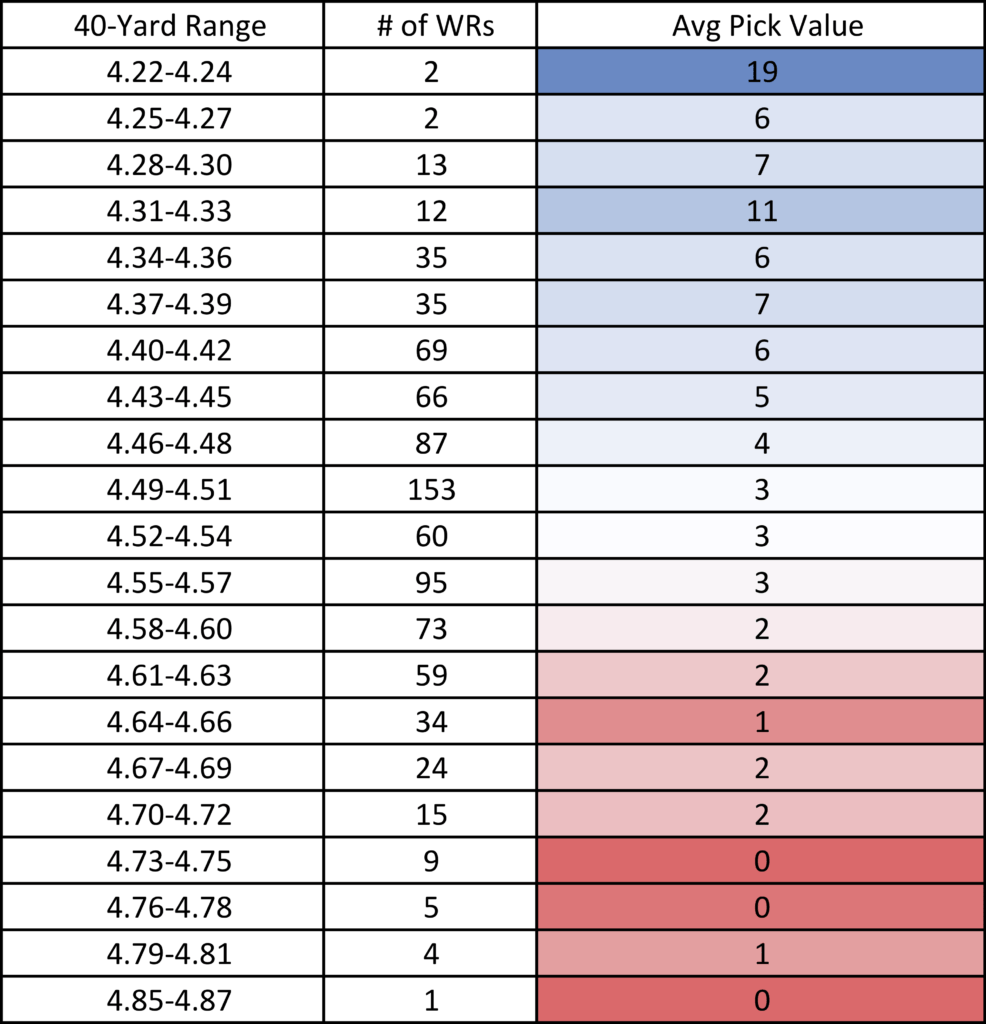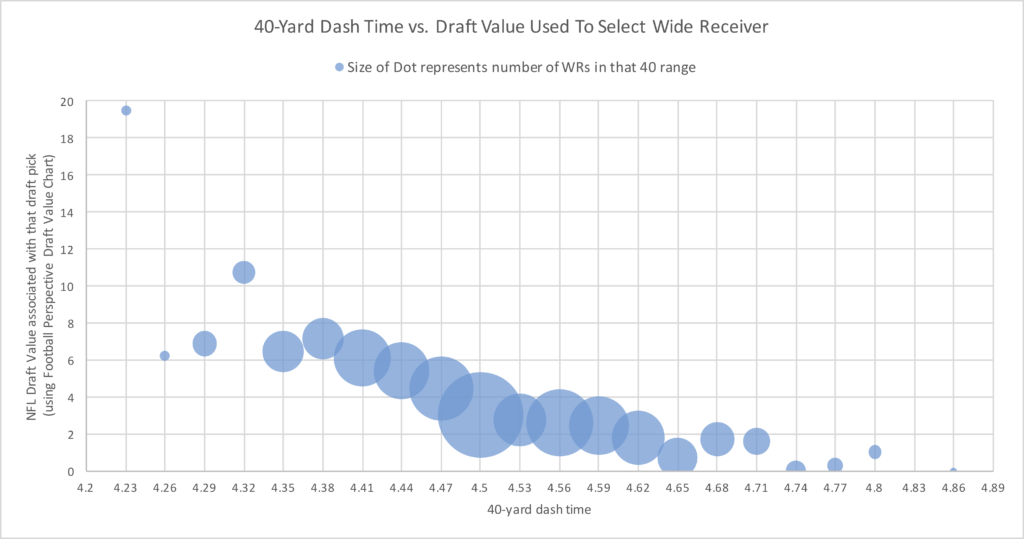In Part I, we learned that there is a correlation between 40-yard dash times and wide receiver success in the NFL. Today, I want to look at a third variable: NFL Draft status.
My sample once again comprises the 853 wide receivers who ran the 40-yard dash at the NFL combine from 2000 to 2017. All data is publicly available from PFR, via Stathead Football. If you think there was a strong correlation between 40-yard dash time and NFL production, wait until you see the correlation between 40-yard dash time and draft status.
In the table below, the average draft value represents the FP draft value associated with each pick. A higher number means more draft value — i.e., an earlier pick — was used to select those players.
 As a reference point, the 32nd pick is worth 12.5 points of draft value, while the 100th pick is worth 5.3 points; you can see all pick values here. Remember that this sample includes every wide receiver — many of them not elite prospects — at the combine. Despite that, players who run the 40 in under 4.34 seconds tend to be drafted very highly. There were 29 wide receivers from ’00 to ’17 who ran the 40 at such a fast mark and 8 were first round picks and 5 more were second round picks. Only three of these sprinters — JJ Nelson, Tiquan Underwood, and Aaron Lockett — were drafted after the fourth round. This trend has held up from ’18 to ’20, with all five players who ran the 40 in under 4.34 seconds going in the first two rounds, including Raiders wide receiver Henry Ruggs III going in the first round.
As a reference point, the 32nd pick is worth 12.5 points of draft value, while the 100th pick is worth 5.3 points; you can see all pick values here. Remember that this sample includes every wide receiver — many of them not elite prospects — at the combine. Despite that, players who run the 40 in under 4.34 seconds tend to be drafted very highly. There were 29 wide receivers from ’00 to ’17 who ran the 40 at such a fast mark and 8 were first round picks and 5 more were second round picks. Only three of these sprinters — JJ Nelson, Tiquan Underwood, and Aaron Lockett — were drafted after the fourth round. This trend has held up from ’18 to ’20, with all five players who ran the 40 in under 4.34 seconds going in the first two rounds, including Raiders wide receiver Henry Ruggs III going in the first round.
Let’s once again graph wide receiver production by measuring 40-yard dash time on the X-Axis and draft status (using the FP Draft Value Chart) on the Y-Axis. But this time, let’s group them in these ranges and use a bubble chart where larger bubbles represent larger sample sizes. For ease of reference, I am using the mid-point of each range, so a player who runs in the 4.52 to 4.54 range will get plotted at 4.53 seconds on the X-Axis. As you can see, there is a strong correlation between 40-yard dash times and draft status, with a few players at the highest speed range really looking like outliers:

Yes, Donte’ Stallworth and John Ross are impacting thigns quite a bit: they were both top-15 draft picks and the only wide receivers to run the 40 in under 4.25 seconds. Meanwhile, Michael Clayton was the only one of the 67 wide receivers to run the 40 at 4.65 or slower to go in the first round.
Let’s summarize. We know three things: [1]Well, the third bullet point wasn’t proven in this series, but we know this to be true and it has been proven in other articles.
- 40-yard dash times and correlated with being productive in the NFL
- 40-yard dash times are also correlated with being drafted earlier in the NFL
- Players drafted earlier are more productive in the NFL
Given those three facts, it’s worthwhile to ask the question: if we know a player’s draft status, does knowing his 40-time help us know if he is going to be productive in the NFL? If we have a player who ran the 40 in 4.38 seconds get drafted 30th overall, should we expect him to do better or worse than a player who ran the 40 in 4.58 seconds and was drafted 20th overall? In other words, is one of these variables more important than the other?
If you believe the draft is perfectly efficient, then the answer is no: his 40-yard time was incorporated into his evaluation, and so we should expect the higher drafted player to do (slightly) better.
If you believe that 40 times are overrated by the NFL, you would think that a player who ran the 40 in 4.38 seconds and was drafted with the 30th pick should do WORSE than a player who ran the 40 in 4.58 seconds and was drafted say, at 40th overall. That’s because you think NFL decisionmakers overstate the importance of the 40, and the guy who ran the 40 in 4.58 seconds and still was drafted at 40th is the better receiver than the guy who “shot up the board” and was overdrafted at 30 after a great combine.
Finally, if you believe that 40 times are underrated by the NFL — not a widely-held view, but still reasonable to presume — then you would think that 40 times are still correlated with success in the NFL even after you account for draft position.
So before we go on, what do you think?
References
| ↑1 | Well, the third bullet point wasn’t proven in this series, but we know this to be true and it has been proven in other articles. |
|---|
